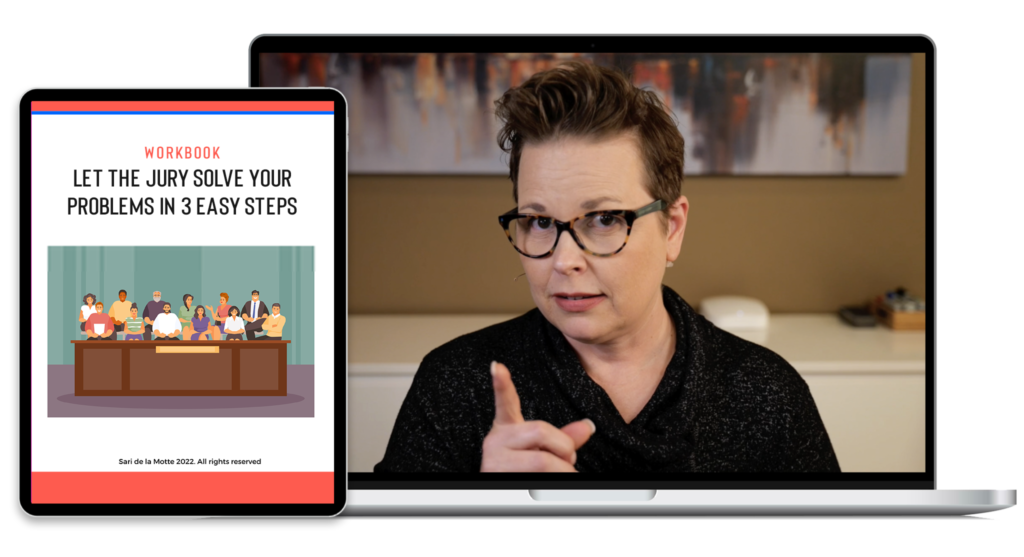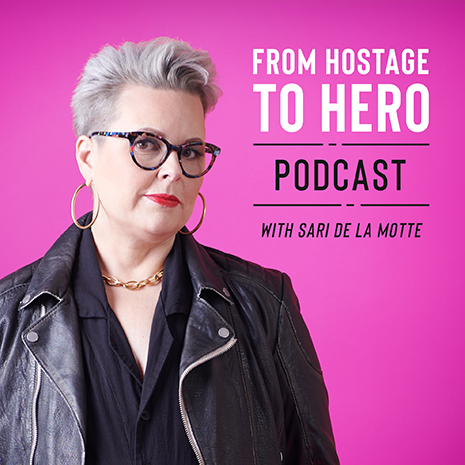The truth is, facts ALONE won’t get you the 6-FIGURE WINNING VERDICT.
If your voice is stuck in monotone (which I know most of y’all are guilty of, because that’s one of the very first things we work on… AHEM!), you’re handing your jury an invitation to…
MENTALLY. CHECK. THE. FUCK. OUT.
In this episode, we break down how to harness genuine emotion by diving into the minor mindset shifts and vocal tweaks that transform bland openings into compelling, authentic, jury-winning stories.
Tune in and learn exactly how to dial up the emotion (without tipping into full-blown theatrics) and MASTER the sweet spot that moves jurors from PASSIVE LISTENERS to ACTIVE BELIEVERS.
Xo,
Sari
➡️FREE FB GROUP FOR PLAINTIFF & CRIMINAL DEFENSE ATTORNEYS
“You want big verdicts? You’ve got to go there emotionally. This is why the Crew exists, by the way. A big reason. Because we know that figuring out how to put an opening statement together or which voir dire questions to ask is just the start. That alone won’t get you where you need to go. ‘Let me put some emotion in my voice’ is not going to do it. Why? Because you’re never going to put emotion in your voice until you feel you’re able to risk emotionally and be vulnerable. That’s what it takes.”
— Sari de la Motte
ENCORE EPISODE TRANSCRIPTION
Hello, darlings. How are you? How is your summer going? I am so excited to be with you today. We’re going to talk about how much emotion—or how much... What the fuck did I call this one? Let me look. How much emotion should I show in opening? There it is. Now we’ve got it.
Before we talk about that, which is a really juicy, awesome topic, I want to talk about some emails. Are you getting my love notes? That’s what I’m calling them. If you’re not getting our love notes, you need to go to https://sariswears.com/about/ and sign up. Actually, let me go there right now. At the bottom of https://sariswears.com/about/, you can sign up. Not totally at the bottom, but you can sign up for my shit. Whatever’s on my brilliant fucking mind is what our marketing team has put in there.
I just wanted to—instead of a reader shout-out—read something that somebody sent me a few weeks ago, maybe about a month ago. This person said they were my soulmate. I said, “I have a soulmate?” She wrote,
“You are my soulmate.”
“Yes, there are a lot of us. I’m sure many are in your H2H Crew, and some are just lurkers who’ve listened to your podcast since you began, who cried when we learned of your diagnosis, who silently rooted you on through your treatment, and who admire your wicked badassness.”
I just love that. I reply to every single email. If you want to get those emails and start feeling the Sari love, go ahead and sign up and please reply. I would love to hear from you.
Speaking of the Crew, we are going to be reopening that in late September or early October at the time of this podcast. I’m not exactly sure, but it’ll be this fall. You definitely want to make sure you get in there. Get on the waitlist. You can also do that at fromhostagetohero.com. The Crew is awesome. It’s where we get to play with all this stuff. I’m teaching you all these cool things—we’ve got our free course, also at fromhostagetohero.com/training—but we do so much more in the Crew. You’re just learning the basics here. Get in the Crew to dive deep into group dynamics, into resident conversations, into all of the cool-ass shit. It’s happening back there.
Let’s talk about this concept of how much emotion to show in opening statement, because this has been coming up a lot in the Crew. There’s a lot of resistance to showing emotion. I talked four or five podcasts ago about the journey from presentation to performance.
This is where I think y’all are getting it wrong—you believe that an opening statement is about delivering information. As I said in that podcast, if that’s what you believe, if that’s what you think it’s for, then why don’t we just type up our opening statements and have the jury read them? You are not needed at all in that scenario.
No, what we’re needing to do is to motivate the jurors to act. Let’s go back to the CTFAR model for a minute. What actually creates action? The CTFAR model is Circumstance, Thought, Feeling, Action, Result. Let’s just look at the TFA part. We have a thought about something, that creates a feeling, and then that produces an action. Notice how if we go just to the Feeling and Action, the feeling is what creates the action. Emotion is what drives human beings, period, end of story.
If you want to motivate jurors (which is, again, the hard thing about your job as plaintiff attorneys: you have to motivate jurors to do something, and the easiest thing is for them to do nothing) you’ve got to tap into emotion.
Now, there are some caveats, and I’m going to share that at the end. There’s particularly one question, one caveat, one warning, and we’ll talk about that. But here’s what I continue to hear from you: you can’t feel, you can’t cry, you can’t get angry. What I’m here to say is, that is bullshit. It’s bullshit.
I firmly believe that the reason why you’re saying those things is because you have a resistance to being emotional. I think most of us do—it’s a vulnerability. When we’re talking about this whole idea of having range and being more emotional at trial, let’s go back to that idea of the devil’s advocate question. I talked about this in several podcasts, about how you cannot use the devil’s advocate question unless you use a different tone of voice.
Kristi Foster, who’s our resident vocal coach here at H2H (she is awesome) if you want to get a free vocal assessment or free breath-work assessment, go to sariswears.com. Yes, it’s confusing, but we’ve hired a branding team and soon we’ll have just one website. For now, go to sariswears.com, “Meet Sari,” and scroll down to her. You can get a free vocal assessment. Here’s what she posted in our H2H group recently:
“I’ve been coaching around this a lot lately, and it came up again today in voir dire circle. Here are some late-night thoughts on the devil’s advocate question. There’s resistance to making your voice go outside its natural range (you feel silly, you’ve not used your voice in that way before, it’s not how you normally speak). But you are not in normal circumstances. It’s time to try new things. Doing a devil’s advocate question is the perfect time to go out of bounds. You must make the question sound ridiculous, or you’ll end up confusing the jurors. If you use the same vocal pitch, melody, volume, pace, and tone that you use throughout the rest of voir dire (when you were being sincere and earnest) they’ll think you’re being sincere and earnest now too.”
She goes on to say you’ve got to make it sound a little ridiculous for them to lock in their opinion on your principles. They have to know that you know the answer, and you know that they know the answer, so it’s just another chance for everyone to confirm it. She says if you don’t take vocal risks, you’re sabotaging yourself. Get your voice ridiculously high as you start the question, then let it cascade down toward normal range to finish. Scrunch your face, gesture, dare to be ridiculous so everyone’s sanity is confirmed.
Yes, Kristi is incredible and absolutely right. The same resistance is the resistance you hold for having emotion in trial. Here’s what I’ll say about that:
I had my three VIPs come out in May. These are the people I spend most of my time with over a year. I take three every year. You have to be in the Crew even to be considered. If you want to work with me one-on-one and change your whole fucking life (because that’s what that program does: my VIP program), you’ve got to be in the Crew to get started. It’s invitation-only. I watch, I look, I see, and then I pick who I want to play with for a year. It’s awesome.
They came out in May, and the jurors said consistently, when the person wasn’t showing emotion, “Why aren’t you more mad about this?”
Just think about that.
The jury is looking to you. Everything we do at H2H is to create permission with jurors, which I talked about a couple of episodes ago, so they’re so receptive to you. There’s rapport that’s naturally happening. They’re looking to you now. You’ve created that great rapport and permission in voir dire, and now in opening, you just deliver information in a flat tone of voice? They’re confused. They’re like, “Wait, what? They did this horrifying thing and you’re acting all normal?” That’s cognitive dissonance.
You have to go first. You have to give them permission to feel. As their leader (because you formed the group in voir dire, presumably, if you did it right, and you have that rapport) now you’re talking about horrifying things, which is basically every plaintiff case: horrifying abuses, rules that are broken, mangled bodies, death. You show no emotion around that?
Not only that, you set the tone at trial. One of my VIPs did an opening and was pretty damn near snark—just disgust in his voice at what had happened in the case—and the jury fucking loved it. Listen, we can’t advocate in opening, we’re not supposed to argue, but you can make your voice sound argumentative. Holy hell, yes, you can. You can show the jury what you think and what they should think, because that’s the point: you are teaching them how to feel. You’re giving them permission to feel. You set the tone at trial. You want big verdicts? You’ve got to go there emotionally.
This is why the Crew exists, by the way. A big reason. Because we know that figuring out how to put an opening statement together or which voir dire questions to ask is just the start. That alone won’t get you where you need to go. “Let me put some emotion in my voice” is not going to do it. Why? Because you’re never going to put emotion in your voice until you feel you’re able to risk emotionally and be vulnerable.
That’s why we have a huge coaching component in the Crew. That’s why so many members go on to hire our coaches privately, because they know that’s what it takes to be a trial attorney who gets big verdicts: you have to be willing to go here. It’s not a technique or a skill; you must do the work on yourself.
One reason I was so drawn to Rick Friedman when I read his On Becoming a Trial Lawyer is that he said trial work is personal work. Being a trial lawyer will show you who you are. Are you willing to do that work? Because that’s what it takes. It’s not just a performance.
Jurors (research says) make decisions and take action from emotion. If you are an emotionless blob in opening, they’re not going to do shit. You’ve got to go there.
We talk about having range in your storytelling (range in your voice) being very fabulous. Kristi Foster also says that if you keep the same tone of voice, not going high or low, not loud or soft, not fast or slow, if it’s the same all the time, jurors start to tune out because they don’t think anything new is coming. The same sound hits their ears, so they assume you’re not giving them anything new to pay attention to, so they check out. When you have range (sometimes high, low, loud, soft, fast, slow) they never know what’s coming next, so they keep listening.
You might think, “How can I do this for two hours?” Sorry, you can’t, and you shouldn’t. Stop doing two-hour openings. That’s crazy. 30 minutes, tops. If you can’t do it in 30, you can’t do it in two hours. They’ll tune out no matter what you do. You could be standing there dancing naked (they’ll still tune out after two hours). Maybe if it was me with my weird skin boobies, as my daughter calls them.
Anyway, let’s get to the rule of thumb: how much emotion do you show?
Here’s the question: Who does it serve?
If you’re having emotion because you personally feel overcome, that serves you. That’s about you and your feelings. But if the emotion serves the jury and the situation (if it properly says to the jury, “This is tragic” or “This is angering”) then it’s okay. If it serves you, if you can’t manage it on your own, if it becomes about you, that’s too much. That’s the line for me: Who does it serve? If it serves the situation, then go for it.
Here’s the caveat: never get ahead of the jury emotionally. I think you need to start and show them, but as you start and set that tone and they’re with you now, don’t go so far there’s no room for them. Again, who does it serve? If you get so angry, the jury might do the opposite to maintain equilibrium. If there’s too much anger or sadness, they’ll become calmer or more detached. Leave room for the jury. Get in there, get emotional, and work on your shit. We can help you in the Crew.
I love you. I know I was preaching today, but that’s because I love you, right? Mama Sari signing off. Bye-bye.
Have you ever wished you knew what the jury was thinking? Well, grab a pen and paper because I’m about to give you instant access to a free training I created for plaintiff trial attorneys. It’s called Three Powerful Strategies to Help You Read a Juror's Mind, and it will help you understand what the jury is thinking so you can feel confident and trust yourself in the courtroom.
Ready? Head to sariswears.com/jury and enjoy!


Free Training
3 pOWERFUL STRATEGIES TO HELP YOU READ A JUROR'S MIND
Let the Jury Solve Your Problems in 3 Easy Steps
Join me for a free training to understand what the jury is thinking so you have the confidence to trust them - and yourself - in the courtroom.
Use the H2H Funnel Method so that jurors tell YOU the principles of the case instead of you telling THEM.

Subscribe to the Podcast
Tune in weekly as Sari shares tips that will help you up your game at trial, connect with jurors, and build confidence in your abilities so that you’ll never worry about winning again.
Sign up for trial tips, mindset shifts, and whatever else is on Sari’s brilliant fucking mind.




